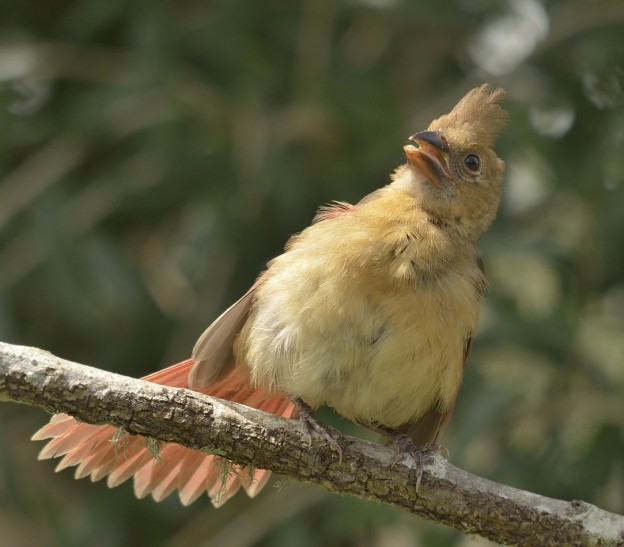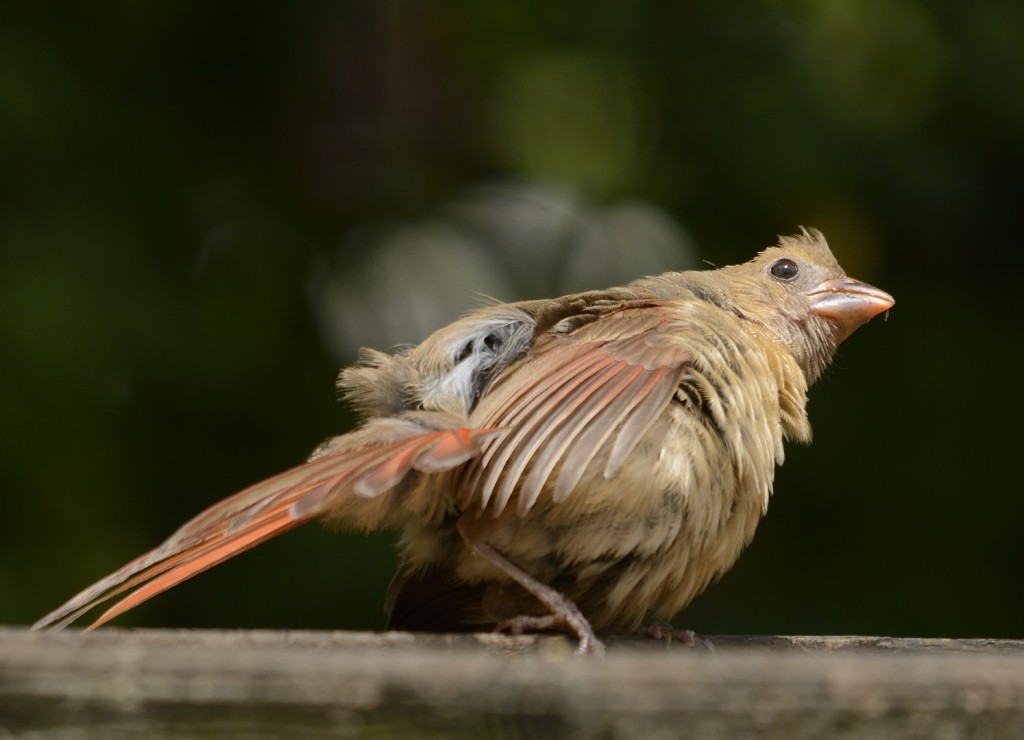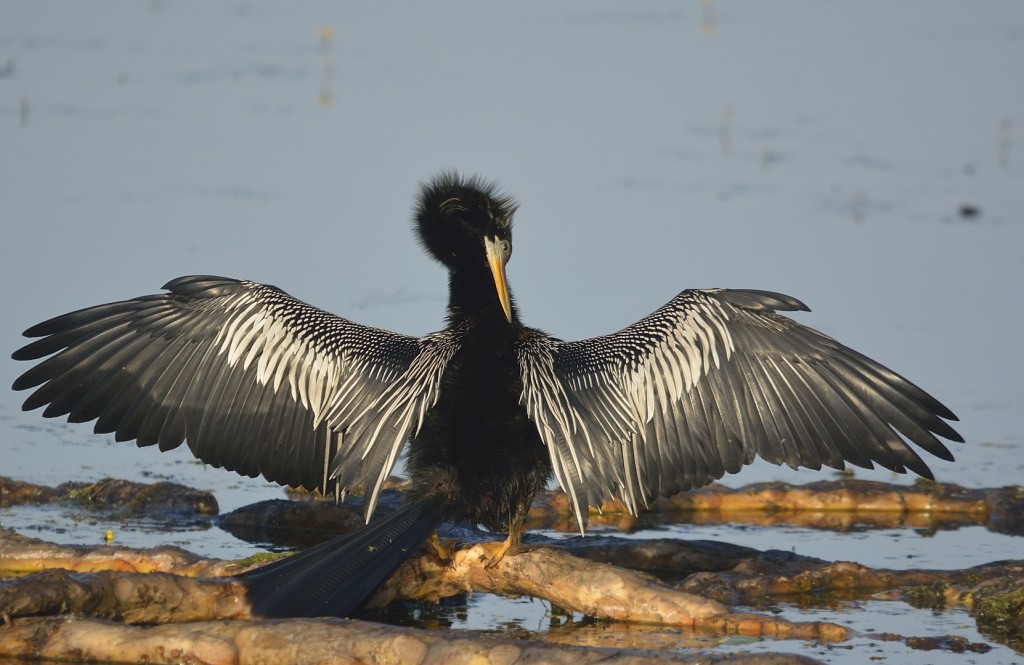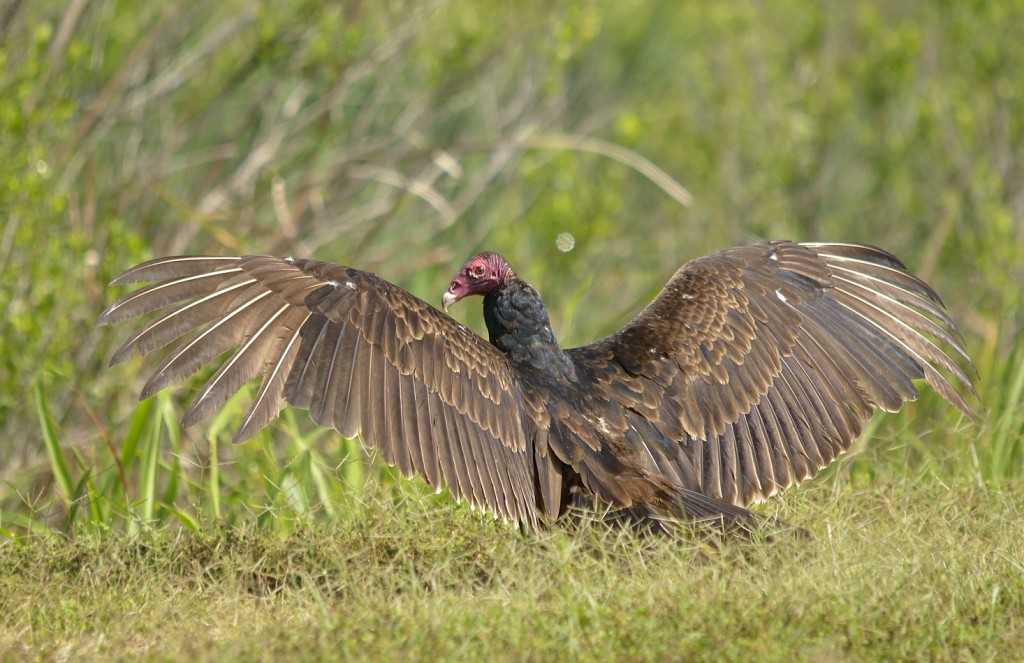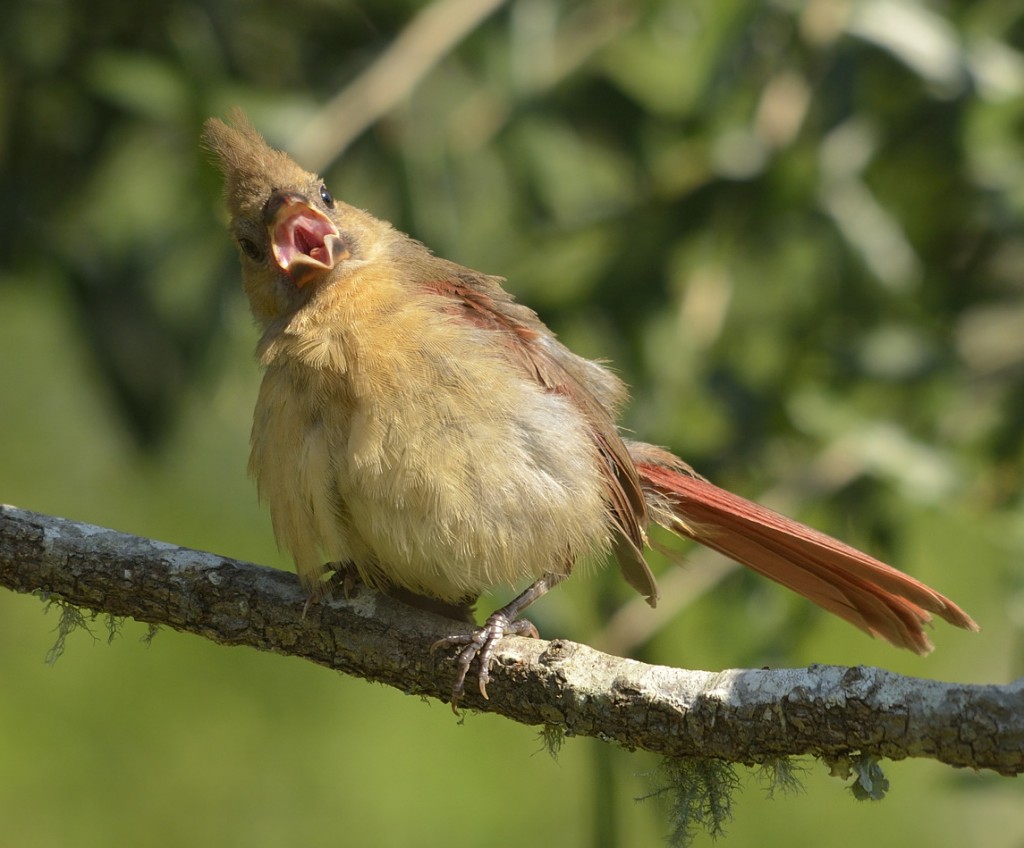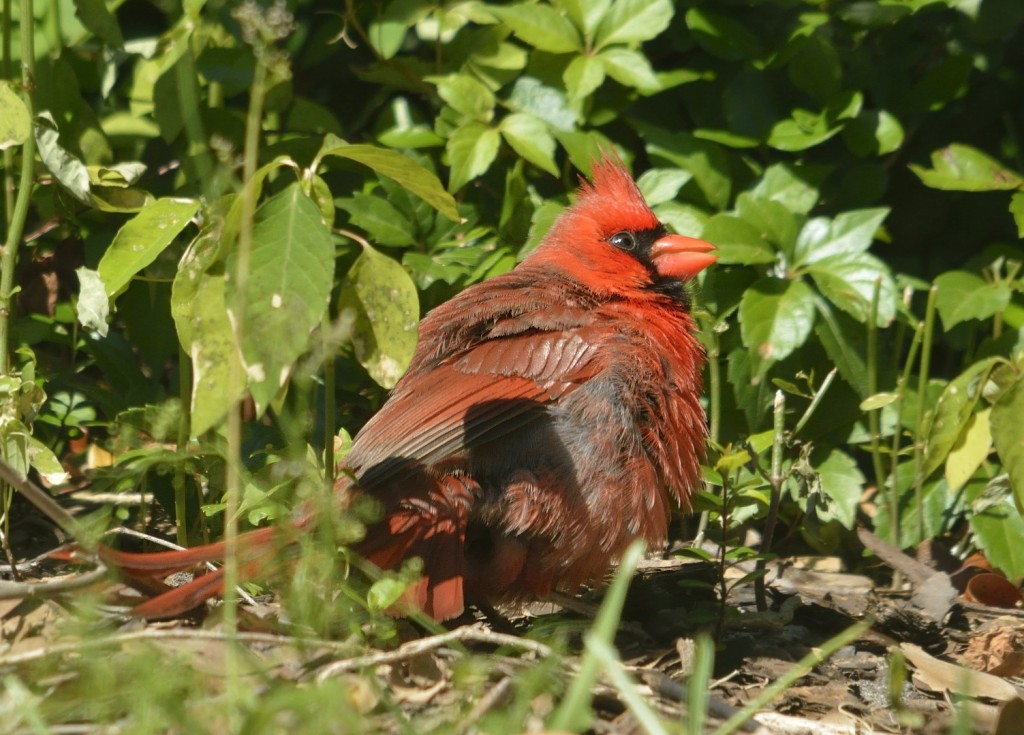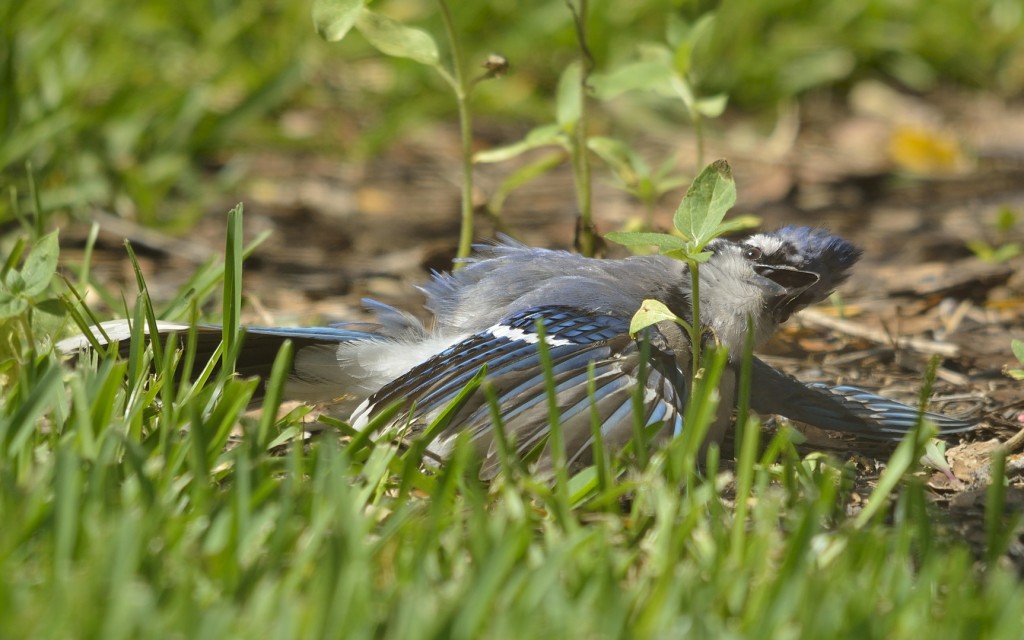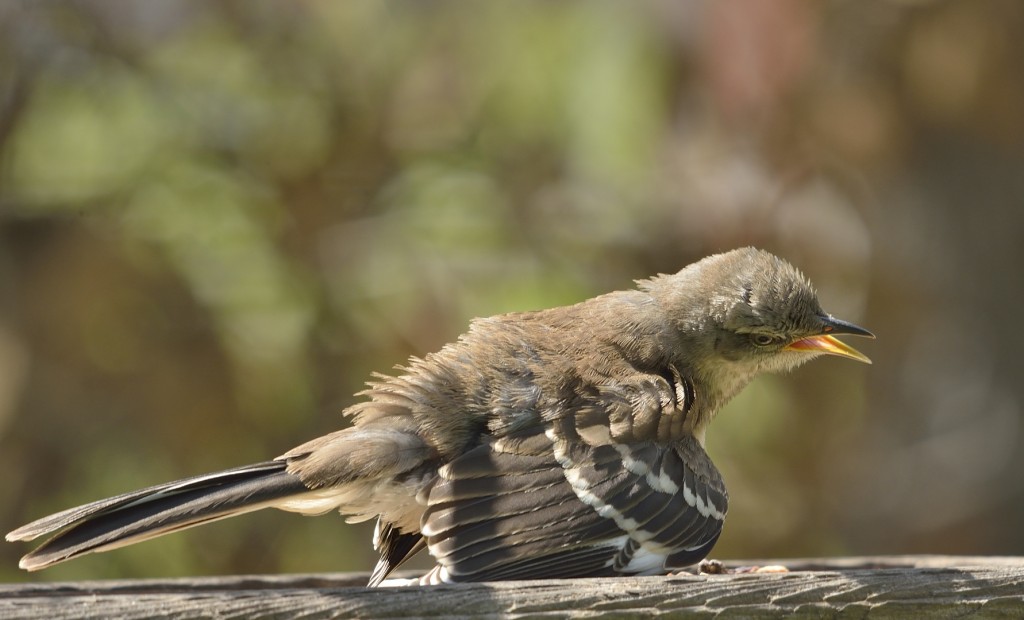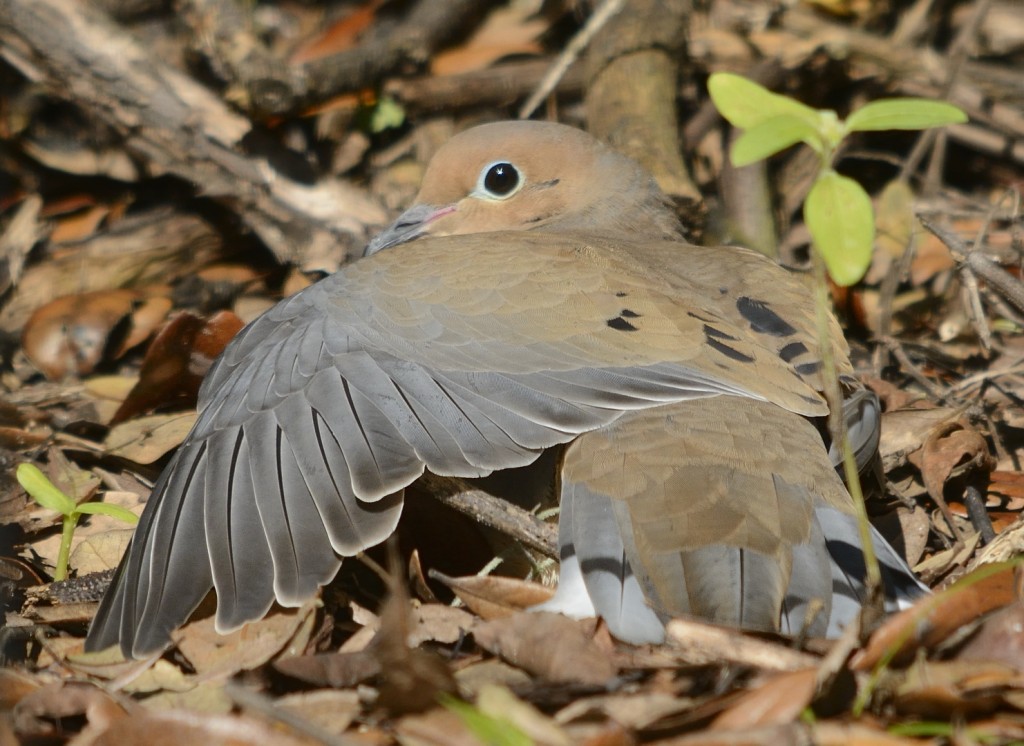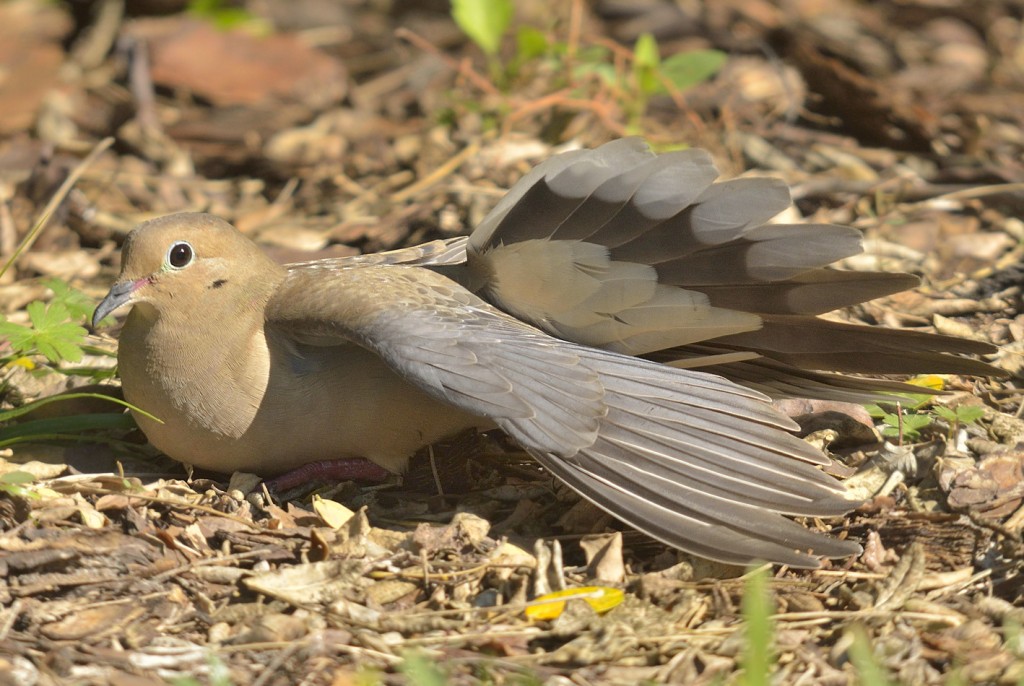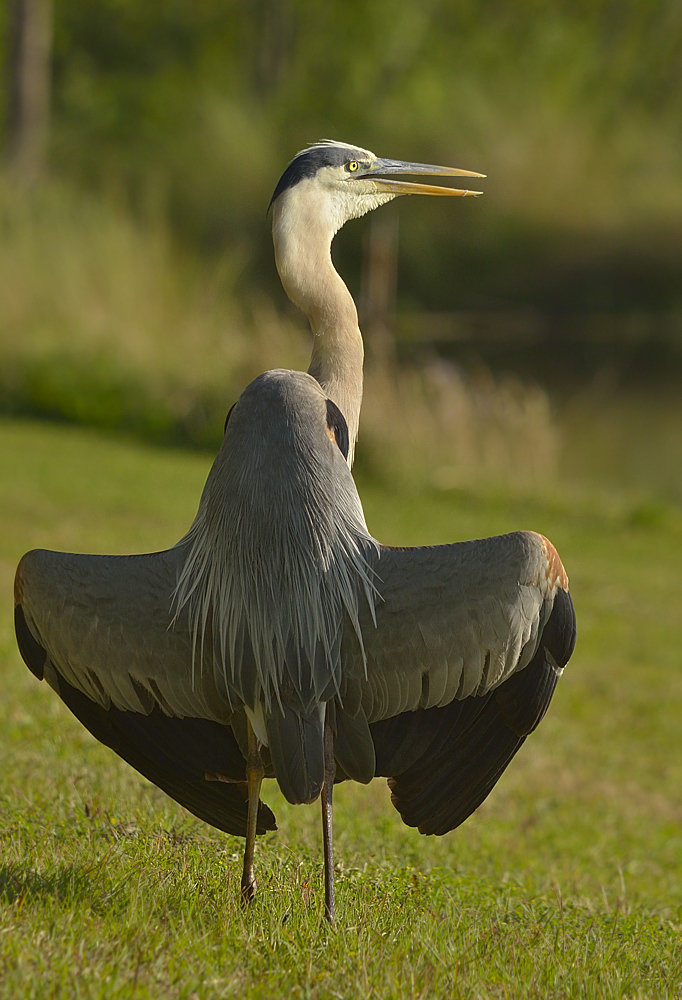July 11, 2014
A young northern cardinal visits a feeding tray exposed to full sun, around mid-day. She begins to pick through the variety of seeds, but after a few moments of feeding, her behavior changes as if someone threw a switch. She stops sorting seeds, leans strongly to one side, cocks her head at an angle so that she appears to be looking directly at the sun with one eye, and she fans out her wings and tail while fluffing out most of her body plumage. She holds this posture for a half-minute or two, and then resumes normal feeding. Over the next several minutes, she adopts this stereotyped posture several more times, sometimes lying flat on her abdomen and extending both wings to the side. Each time she switches from feeding to posturing, the transition is almost immediate. It’s very amusing to watch.
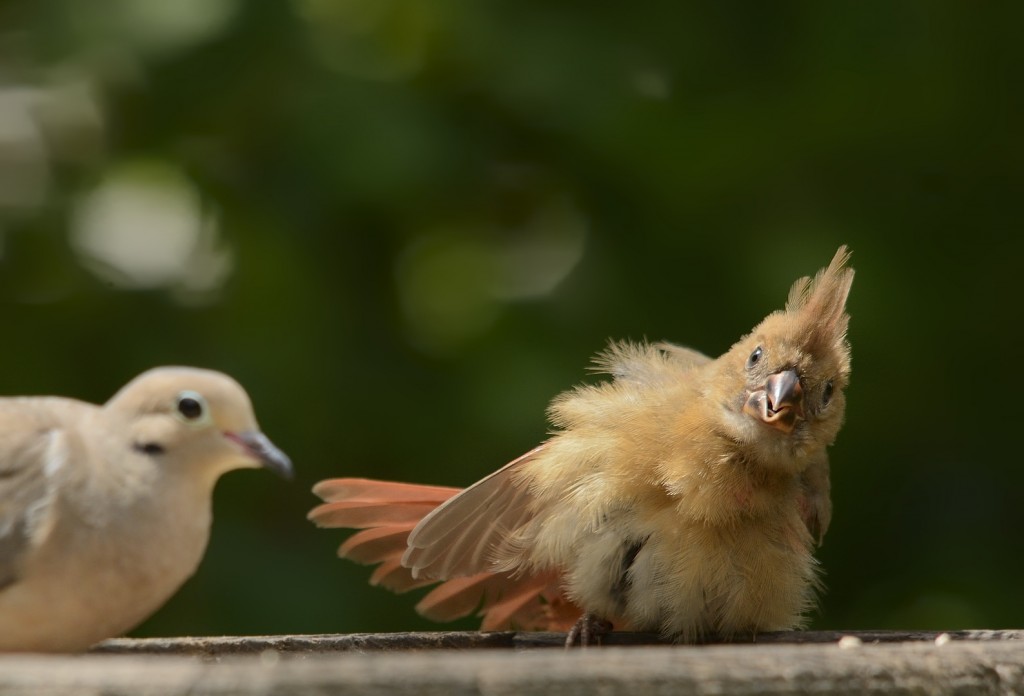
Cardinals frequently switch between feeding and sunning when at the feeder. Mourning doves seem to restrict their sunning behavior to the ground.
This hen cardinal is engaging in sunning, a widespread yet poorly understood behavior. Sunning postures of various sorts have been reported in over 50 families of birds. Way back in 1957, Doris Hauser published a paper reporting her observations of sunning behavior in 33 species of birds from Florida and North Carolina. In the last several decades there has been a lot of research on thermoregulation in birds and the importance of basking behaviors in regulating body temperature, yet there has been very little peer-reviewed research on the types of sunning behavior Doris Hauser documented. It’s still not clear why they do it.
The most obvious explanation is simply regulation of core body temperature; birds are mostly endothermic (“warm-blooded”), using metabolic heat to maintain a high body temperature. However, many birds use ectothermy (use of external sources of heat to regulate body temperature) occasionally to supplement their metabolically-derived heat, and lower their energy needs by doing so. Both turkey and black vultures are frequently seen basking in the morning before they leave the roost. Roadrunners have a characteristic body posture they use to bask early in the morning; basking birds reduce their metabolic rate by up to 40% compared with other roadrunners in the same conditions that aren’t basking. Anhingas and cormorants both use stereotyped, spread-wing basking postures to aid in drying their wings after diving.
But that’s not what the hen cardinal was doing, or the other species in Hauser’s study. In all of these birds, sunning is most frequent when air temperatures are high, and the bird is in strong, direct sunlight. Using external heat to maintain their body temperature isn’t needed in these conditions – the bigger problem for birds sunning at mid-day is keeping their body temperature from rising too high. Many species engage in gular flutter or panting while they are sunning; these behaviors increase the flow of air over their mouth and throat, evaporating water and cooling the bird off in the process. So these birds are adopting postures that expose as much body or feather surface as possible to direct sunlight, and in the process are absorbing so much heat that they have to use evaporative cooling to prevent overheating. It doesn’t sound like body temperature regulation is the main adaptive function for my cardinal hen. I see this same behavior, with the same general pattern of occurrence, in red-bellied woodpeckers, mourning and ground doves, blue jays, northern mockingbirds, Carolina wrens, tufted titmice, and cardinals.
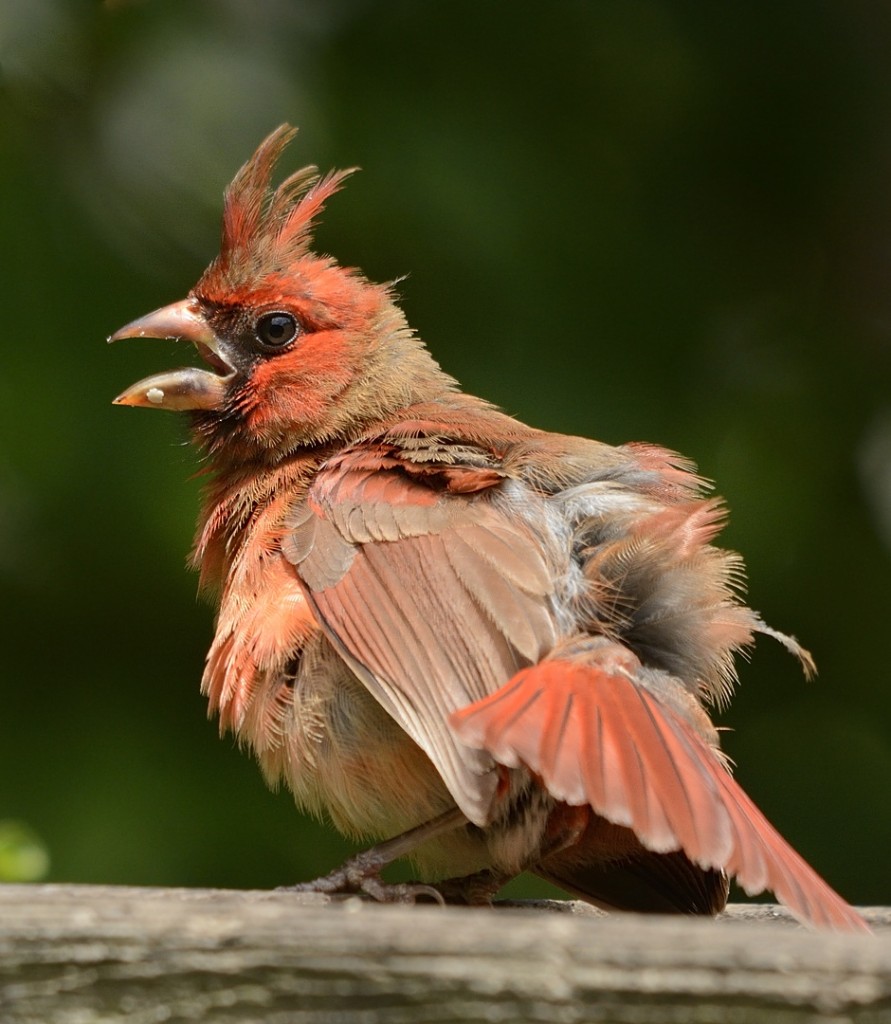
Many birds pant and perform gular flutter while sunning, an indication that their core body temperature is at risk of rising dangerously high.
The transition between other behaviors and sunning can be so abrupt that it seems to occur almost as an involuntary reflex in response to a specific set of environmental conditions, including ambient temperature and strength of insolation. Hauser suggested that there are actually two behaviors involved – voluntary and compulsive sunning. I’m not sure if many bird physiologists or behaviorists buy the latter, but it’s easy to see how she came to this conclusion; initiation of sunning behavior often appears as if it is beyond the bird’s conscious control, as if some internal switch were thrown and they are compelled to obey the urge.
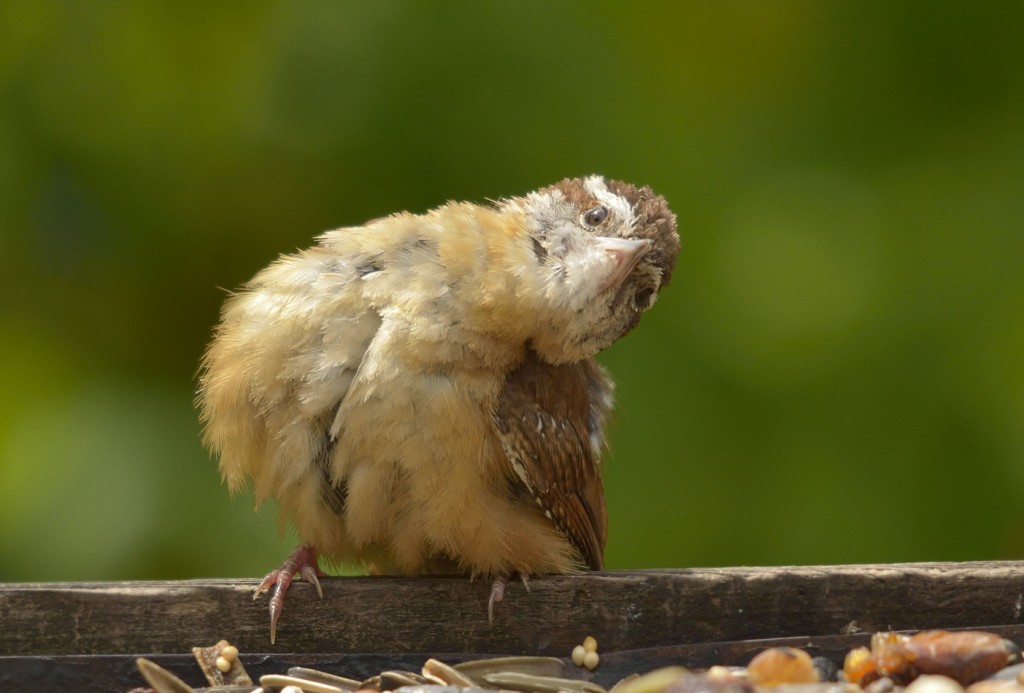
Sunning postures can be partial or complete. This Carolina wren has cocked his head to increase insolation, but hasn’t done the complete prostrate collapse yet.
Other benefits of sunning have been suggested. Components of preen oil have been shown to convert to Vitamin D when exposed to sunlight, which may then be ingested when the bird preens; direct insolation of exposed skin almost certainly increases Vitamin D production by the cells of the epidermis, as it does in most vertebrates.
The explanation that makes most sense to me is that sunning is a way of controlling ectoparasites, like feather lice, mites, fleas, and ticks. The idea is that what the birds are doing is heating their skin and feather surfaces to high temperatures that the bird can endure for short periods of time, but the parasites can’t. High skin/feather temperatures may kill some ectoparasites directly, or it may cause them to move around more trying to avoid the heat, allowing the preening bird to pick them off more easily. Sunning behavior is often combined with bouts of preening.
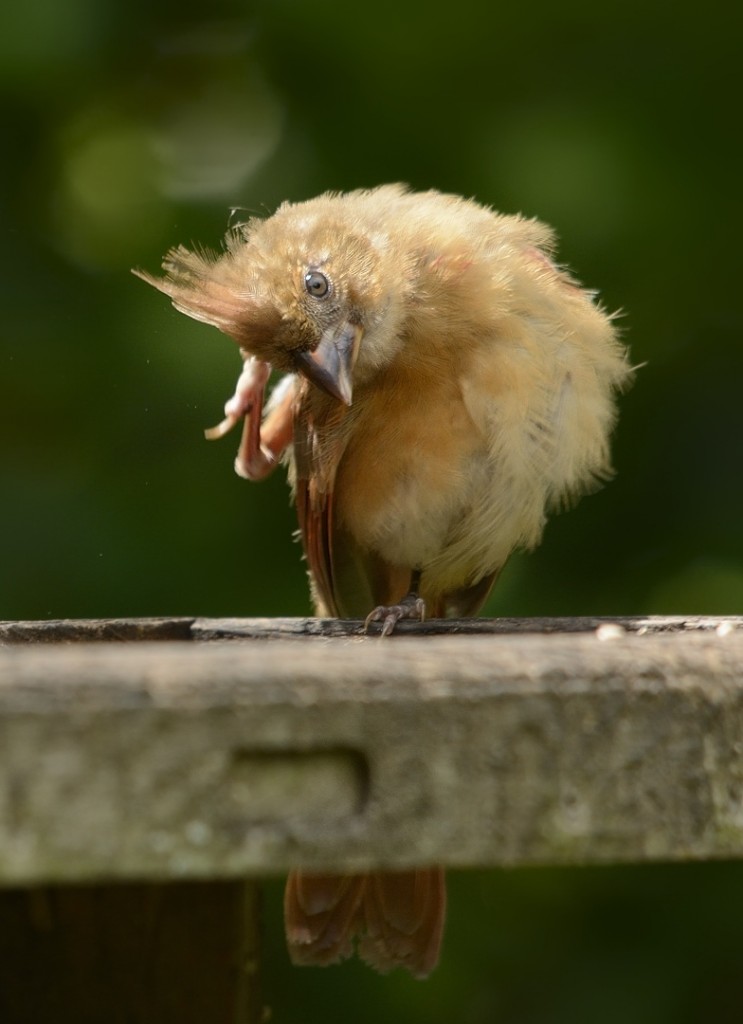
Many birds preen or scratch immediately after sunning, perhaps because ectoparasites are moving around on their skin in response to the heat.
The only experimental study I’m aware of testing this idea used artificial wings made from feathers of black noddies (a widespread oceanic tern), that were exposed to two conditions – sun vs. shade. The researchers placed feather lice collected from wild noddies on the wing feathers, and recorded their fate. Wings “basking” in the sun reached temperatures high enough to kill about half of the lice, while lice on wings in the shade all survived. It’s not surprising that black noddies spend a lot of time in their stereotyped sunning postures.
The ectoparasite hypothesis and the Vitamin D hypothesis are not mutually exclusive; it’s entirely possible that birds involved in sunning are increasing their fitness in multiple ways.
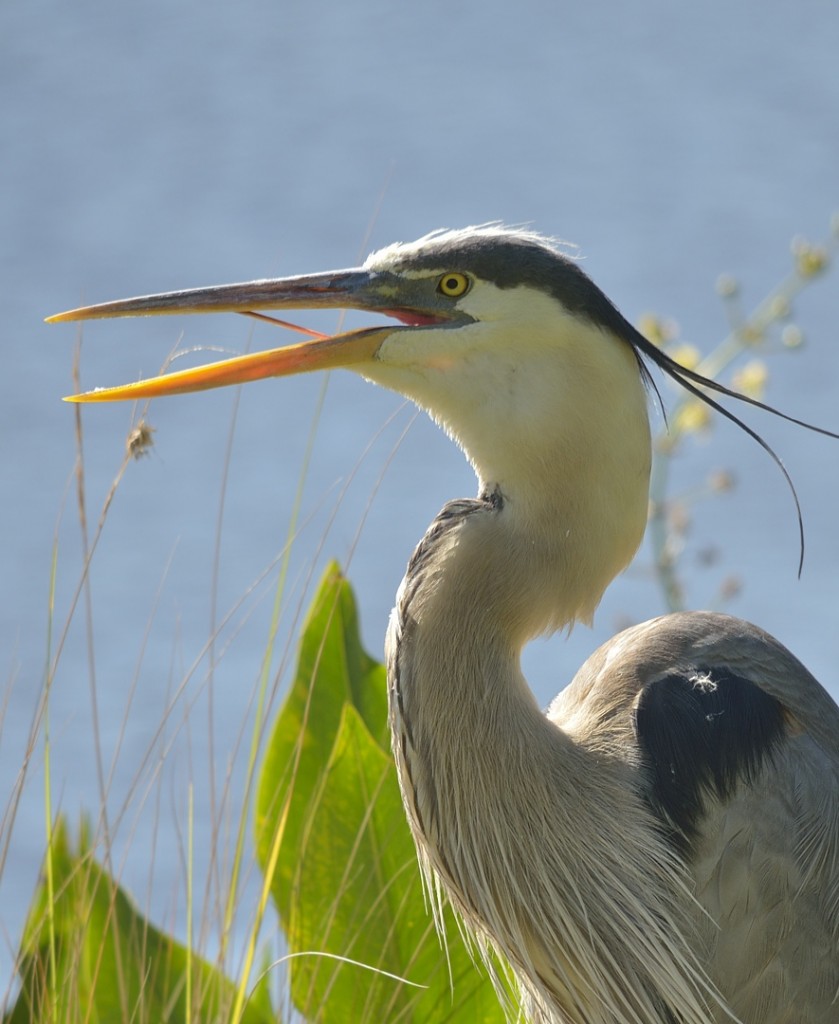
An open-beak posture is often a sign that the bird is overheated, and using evaporative cooling from the respiratory surfaces to cool down.
The taxonomic range of birds that use some form of sunning posture, presumably to control parasites, is broad. For many years I puzzled over the basking behavior I sometimes see in great blue herons, in which the bird faces the sun and droops its wings to the side to form a sort of parabolic dish with which to collect sunlight. I nearly always see this behavior in hot weather, rarely in cold. The herons are nearly always engaged in gular flutter, bills agape to dissipate excess heat. The apparent paradox of birds basking to the point of hyperthermia had me scratching my head for a long time. I still scratch my head a lot, but for new and improved reasons.
References
Clayton, D. H., Koop, J. A., Harbison, C. W., Moyer, B. R., & Bush, S. E. 2010. How birds combat ectoparasites. Open Ornithology Journal: 3, 41-71.
Hauser, D. C. 1957. Some observations on sun-bathing in birds. The Wilson Bulletin, 78-90.
Moyer, B. R., & Wagenbach, G. E. 1995. Sunning by Black Noddies (Anous minutus) may kill chewing lice (Quadraceps hopkinsi). The Auk, 1073-1077.
